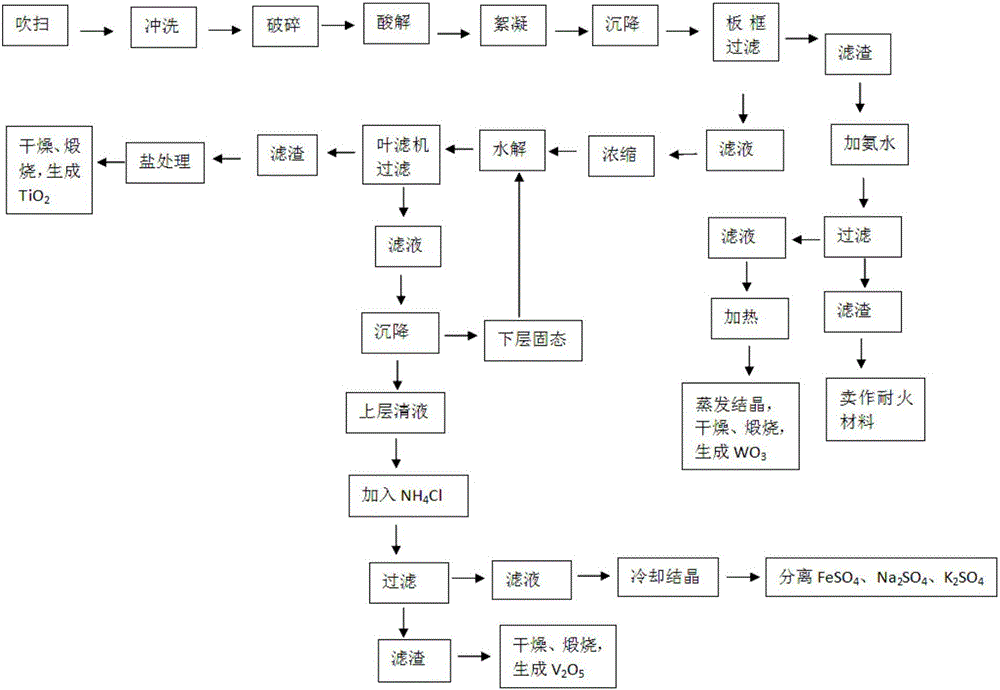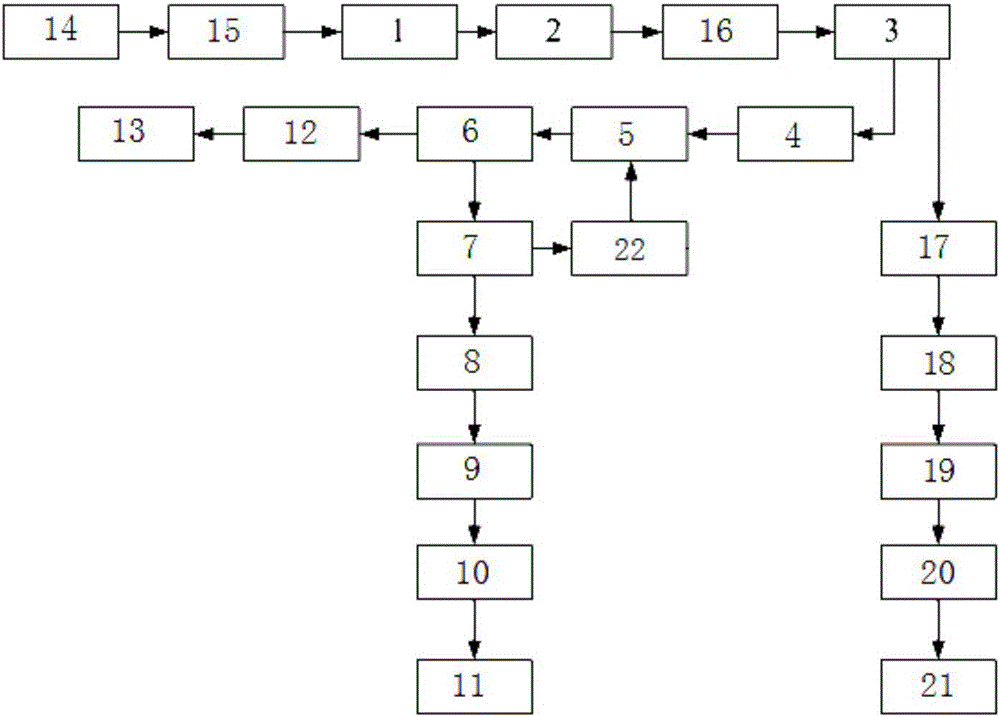Method and device for recycling Ti and V from waste flue gas denitrification catalyst
A denitrification catalyst and waste flue gas technology, applied in the direction of vanadium oxide, titanium dioxide, titanium oxide/hydroxide, etc., can solve the problems of reagent waste, unsuitable for industrial production, low extraction purity and extraction efficiency, etc.
- Summary
- Abstract
- Description
- Claims
- Application Information
AI Technical Summary
Problems solved by technology
Method used
Image
Examples
Embodiment 1
[0055] Embodiment 1 of the present invention: a method for reclaiming Ti and V from waste flue gas denitrification catalyst, such as figure 1 shown, including the following steps:
[0056] S01, use compressed air to purge the waste flue gas denitrification catalyst, and purge each module for 20-23 minutes to remove the dust in the tunnel;
[0057] S02, wash the catalyst after dust removal with a high-pressure water gun, the washing time of each module is 15-20min, and the pressure is 8-12Mpa, further remove the dust in the channel;
[0058] S03, drying the washed catalyst;
[0059]S1, pulverizing the catalyst and adding concentrated sulfuric acid for acidolysis, adding water after acidolysis to obtain a titanyl sulfate solution; specifically including the following steps:
[0060] S11, crushing the catalyst into catalyst powder of 160-180 mesh;
[0061] S12, put the catalyst powder into the acid hydrolysis tank made of lead, add 88%-90% concentrated sulfuric acid according ...
Embodiment 2
[0073] Embodiment 2: a kind of method that reclaims Ti and V from waste flue gas denitrification catalyst, such as figure 1 shown, including the following steps:
[0074] S01, use compressed air to purge the exhaust gas denitrification catalyst, and purge each module for 15 to 20 minutes to remove the dust in the tunnel;
[0075] S02, wash the catalyst after dust removal with a high-pressure water gun, the flushing time of each module is 20-25min, and the pressure is 5-8Mpa, further remove the dust in the channel;
[0076] S03, drying the washed catalyst;
[0077] S1, pulverizing the catalyst and adding concentrated sulfuric acid for acidolysis, adding water after acidolysis to obtain a titanyl sulfate solution; specifically including the following steps:
[0078] S11, crushing the catalyst into 180-200 mesh catalyst powder;
[0079] S12, put the catalyst powder into a lead-made acidolysis tank, add 85% to 88% concentrated sulfuric acid according to the weight ratio of cata...
Embodiment 3
[0092] Embodiment 3: a kind of method that reclaims Ti and V from waste flue gas denitrification catalyst, such as figure 1 shown, including the following steps:
[0093] S01, use compressed air to purge the exhaust gas denitrification catalyst, and purge each module for 23 to 30 minutes to remove the dust in the tunnel;
[0094] S02, wash the catalyst after dust removal with a high-pressure water gun, the washing time of each module is 25-30min, and the pressure is 7-10Mpa, further remove the dust in the channel;
[0095] S03, drying the washed catalyst;
[0096] S1, pulverizing the catalyst and adding concentrated sulfuric acid for acidolysis, adding water after acidolysis to obtain a titanyl sulfate solution; specifically including the following steps:
[0097] S11, pulverizing the catalyst into 190 mesh catalyst powder;
[0098] S12, put the catalyst powder into a lead-made acidolysis tank, add 90% to 92% concentrated sulfuric acid according to the weight ratio of catal...
PUM
 Login to View More
Login to View More Abstract
Description
Claims
Application Information
 Login to View More
Login to View More - R&D
- Intellectual Property
- Life Sciences
- Materials
- Tech Scout
- Unparalleled Data Quality
- Higher Quality Content
- 60% Fewer Hallucinations
Browse by: Latest US Patents, China's latest patents, Technical Efficacy Thesaurus, Application Domain, Technology Topic, Popular Technical Reports.
© 2025 PatSnap. All rights reserved.Legal|Privacy policy|Modern Slavery Act Transparency Statement|Sitemap|About US| Contact US: help@patsnap.com


